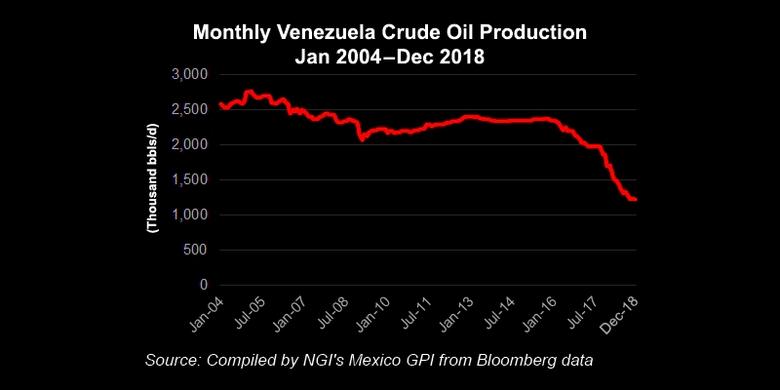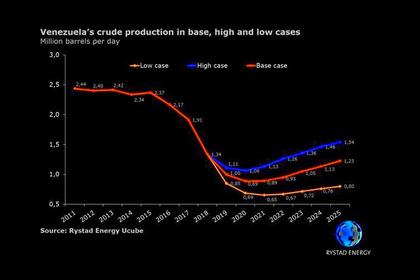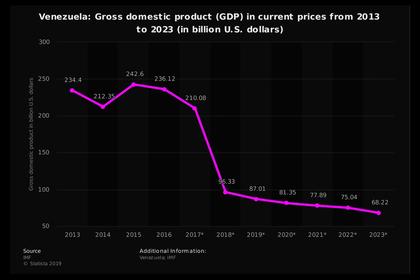
VENEZUELA'S OIL PRODUCTION 840 TBD

EIA - In March 2019, Venezuela's crude oil production (excluding condensate) averaged 840,000 barrels per day (b/d), down from 1.1 million b/d in February, according to estimates in the U.S. Energy Information Administration's (EIA) April 2019.
This average is the lowest level since January 2003, when a nationwide strike and civil unrest largely brought Venezuela's state oil company, Petróleos de Venezuela, S.A.'s (PdVSA), operations to a halt. Widespread power outages, mismanagement of the country's oil industry, and U.S. sanctions directed at Venezuela's energy sector and PdVSA have all contributed to the recent declines. Venezuela's production decreased by an average of 33,000 b/d each month in 2018, and the rate of decline accelerated to an average of over 135,000 b/d per month in the first quarter of 2019. The number of active oil rigs—an indicator of future oil production—also fell from nearly 70 rigs in the first quarter of 2016 to 24 rigs in the first quarter of 2019. The declines in Venezuelan production will have limited effects on the United States, as U.S. imports of Venezuelan crude oil have decreased over the last several years, with average 2018 imports the lowest since 1989. However, there may be upward pressure on the prices of other crude oils imported into the United States.
Venezuela's production is expected to continue decreasing in 2019 and declines may accelerate as sanctions-related deadlines approach. These deadlines include provisions that third-party entities that use the U.S. financial system must cease transactions with PdVSA by April 28 and that U.S. companies, including oil service companies, involved in the oil sector must cease operations in Venezuela by July 27. Venezuela's chronic shortage of workers across the industry and the departure of U.S. oilfield service companies will likely contribute to a further step-level decrease in production.
Additionally, U.S. sanctions, as outlined in the January 25, 2019, Executive Order 13857, immediately banned exporting petroleum products—including unfinished oils that are blended with Venezuela's heavy crude oil for processing—from the United States to Venezuela and required payments for PdVSA-owned petroleum and petroleum products to be placed into an escrow account inaccessible by the company. The imposition of these sanctions has already affected oil trade between the United States and Venezuela in both directions. Preliminary weekly estimates indicate a significant decline in U.S. crude oil imports from Venezuela in February and March, as without direct access to cash payments, PdVSA had little reason to export crude oil to the United States. India, China, and some European countries continued to take Venezuela's crude oil, according to data published by ClipperData Inc., while the destinations of some vessels carrying Venezuelan crude oil remain unknown. Venezuela is likely keeping some crude oil cargoes intended for exports in floating storage until it finds buyers for the cargoes.
A series of ongoing nationwide power outages in Venezuela that began on March 7 cut electricity to the country's oil-producing areas, likely damaging the reservoirs and associated infrastructure. In the Orinoco Oil Belt area, Venezuela produces extra-heavy crude oil that requires dilution with condensate or other light oils produced using complex processing units, or upgraders, to upgrade the crude oil before it is sent via pipeline to domestic refineries or export terminals. These upgraders were shut down in March during the power outages. If the crude or upgraded oil cannot flow as a result of a lack of power to the pumping infrastructure, the heavier molecules sink and form a tar-like layer in the pipelines that can hinder the flow from resuming even after the power outages are resolved. However, according to tanker tracking data, Venezuela's main export terminal at Puerto José was apparently able to load crude oil onto vessels between power outages, possibly indicating that the loaded crude oil was taken from onshore storage. For this reason, EIA estimates that Venezuela's production fell at a faster rate than its exports.
In 2019, Venezuela's crude oil production decline has resulted from a combination of disruptions and lost capacity. EIA differentiates among voluntary production reductions; unplanned production outages, or disruptions; and expected declines in production. For the Organization of the Petroleum Exporting Countries (OPEC), voluntary cutbacks count toward spare capacity. EIA defines spare crude oil production capacity as potential oil production that could be brought online within 30 days and sustained for at least 90 days, consistent with sound business practices.
For all countries, involuntary disruptions do not count as spare capacity. Events that could cause a disruption include, but are not limited to, sanctions, armed conflict, labor actions, natural disasters, or unplanned maintenance. In contrast, EIA considers production capacity declines that result from irreparable damage to be lost capacity and not a disruption. EIA no longer counts the lost production because it is very unlikely that it could return within one year and add to global supplies.
Because the power outages in Venezuela resulted from a lack of maintenance of the electricity grid, associated crude oil production declines are considered lost production capacity resulting from mismanagement. As of the April 2019 STEO, EIA includes the portion of Venezuela's production decline that resulted from U.S. sanctions—approximately 100,000 b/d beginning in February—as a disruption . If sanctions persist, the country will likely be unable to restart the disrupted portion of production and the 100,000 b/d will become lost capacity. Although EIA does not forecast unplanned production outages, its forecast for OPEC production totals will reflect declines in Venezuelan production.
As Venezuelan crude oil has come off the global market and as other countries—including the United States—have produced more light, sweet crude oil, the price discount of heavy, sour crudes has narrowed. U.S. refineries are among the most complex in the world, making them well-suited for the physical properties of Venezuelan crude oil (with high sulfur content and heavier API gravity). Heavier, more sour crude oil is typically priced lower than other crude oils because of differences in crude oil quality. Mars—a medium, sour crude oil produced in the U.S. Federal Offshore Gulf of Mexico—traded at a five-year (2014–18) average discount to Light Louisiana Sweet (LLS) of $3.94 per barrel (b). The Mars-LLS discount has narrowed in 2019, averaging $0.62/b in March, and even reached parity on March 27.
Venezuela's crude oil production is forecasted to continue to fall through at least the end of 2020, reflecting an expectation of further declines in crude oil production capacity. Although EIA does not publish forecasts for individual OPEC countries, it does publish total OPEC crude oil and other liquids production. Further disruptions to Venezuela's production beyond what is currently included would change this forecast.
-----
Earlier:


















